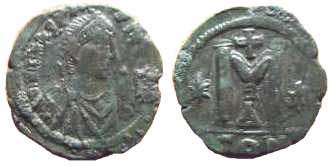| 491 AD - 518 AD |
Anastasius I Constantinopolis Imperium Byzantinum
Αναστάσιος Α' Κωνσταντινούπολις Βυζαντινή Αυτοκρατορία
| Follis / Φόλλις AE 34 |
SHH 1251 |
 |
| Parameter Obverse Reverse Notes Reference |
17.68 g 32.8-34.8 mm 7:00
o'clock VF D N ANAST[A] / SIVS P P AVG; diademed and cuirassed bust of Anastasius right; all within border of dots. Large M on horizontal line; cross above; Δ beneath; star on either side; CON in exergue; all within border of dots. Post reform mint of Constantinopolis, 498-518 AD; large module. BMC 24/27; Dumbarto n Oaks I 23f; SB 19 |
Anastasius
I 491 - 518
David R.
Sear, Βyzantine Coins
and Their Values, B. A.
Seaby, London, 2000
Following the death of the Emperor Zeno, the choice
of a successor devolved on the widowed Empress Ariadne. She selected a
somewhat obscure court official, Anstasius, and despite his advanced
age he ruled the Empire for twenty-seven years and outlived Ariadne
herself.Anastasius' main achievements were in the realms of finance, and it is with his radical changes in the monetary system that the byzantine coinage is generally held to commence. By the time of his death he had increased the resources of the state treasury by something like 320,000 pounds of gold. That his successors were able to embark on grandiose schemes of reconquest must have been very largely due to the financial skill of Anstasius in building up the economic strength of the Empire.
It was in religious matters that the emperor encountered his greatest difficulties. On his accession he had made a formal profession of orthodoxy, but in reality he favoured the monophysite herecy, and as time went by he gradually ceased the pretence. Although this pleased his subjects in the eastern provinces (Syria and Egypt) where monophysitism was rife, it caused great consternation amongst the orthodox Byzantines, and revolts began breaking out with increasing frequency. These culminated in the rebeliion of Vitalian, commander-in-chief of Thrace, who three times advanced on Constantinople threatening to attack the city, before Anastasius finally agreed to change his policy.